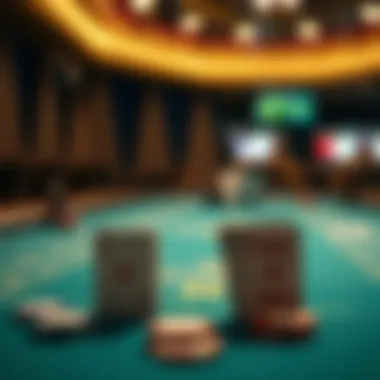The Interplay of Blackjack and Three Card Poker


Intro
In the colorful and lively world of casinos, the interaction between blackjack and three card poker stands out as a fascinating topic worth exploring. Both games have their unique charm, enticing players with different mechanics and strategies. Understanding how they relate can enhance your gaming experience, whether you're trying your luck at the tables or analyzing the games from an industry perspective.
Blackjack, often referred to as twenty-one, is known for its blend of strategy and chance, typically pitting the player against the dealer. Conversely, three card poker is a game where players compete against each other rather than the house. This shift in focus not only alters gameplay dynamics but also invites distinct strategic approaches. As we navigate through this discussion, we will uncover key points about each game, with a particular emphasis on their rules, strategies, and betting techniques.
The significance of this topic extends beyond mere gameplay mechanics. It taps into the psychology of gambling, the mathematical odds involved, and the social aspects that emerge when players congregate around their favorite tables. Through a thorough analysis, newcomers and seasoned gamblers alike will find insight that can potentially elevate their approach to these beloved games.
Prepare to delve deeper into the nuances of blackjack and three card poker, and how they intertwine, providing an engaging landscape for both casual players and hardcore enthusiasts alike.
Prolusion to Blackjack and Three Card Poker
The intertwined world of blackjack and three card poker presents an engaging analysis of strategy, chance, and entertainment which captivates both casual players and seasoned gamblers alike. These two distinct casino games, while sharing certain core principles, also exhibit unique characteristics that cater to different playing styles and preferences. Understanding their dynamics is not merely for the sake of trivia; it empowers players to make informed decisions that can substantially influence their gaming experience and outcomes.
Historical Context of Casino Games
Casino games have roots that stretch deep into history, tracing back to ancient China, where games of chance were played as far as 2000 BCE. Over the centuries, gambling evolved, absorbing influences from various cultures. By the 18th century, games similar to modern blackjack emerged in French casinos, gradually filtering across continents. Three Card Poker, on the other hand, is a relatively recent creation, invented in 1994 by designer David Sklansky. It quickly gained popularity for its fast pace and straightforward betting structure, firmly establishing itself alongside traditional games in contemporary casinos.
Overview of Blackjack
Blackjack, often dubbed as ‘21’, combines luck and skill in a way that few casino games can. The objective is not just to get as close to 21 as possible, but to do so while maintaining a higher total than the dealer. Each card has its own value; cards numbered 2 through 10 are worth their face value, while face cards (jacks, queens, kings) are worth ten, and aces can be 1 or 11, depending on what benefits the player most.
The strategic depth in blackjack is a compelling aspect. Players need to be aware of the dealer’s upcard and how it might affect their own moves. Basic strategy charts have been developed over time, indicating the statistically best actions to take based on one's total and the dealer's visible card.
Overview of Three Card Poker
Three Card Poker diverges significantly from blackjack. This game is designed for speed and simplicity, where players are dealt three cards and compete against the dealer rather than other players. Here, the objective shifts to creating the best possible three-card poker hand. The hands are ranked similarly to traditional poker, where a straight flush beats three of a kind, for example.
The fast-paced nature of Three Card Poker allows for quick bets and rapid rounds, making it a favorite among players who prefer a more immediate gaming experience. Players can also engage in additional betting options, like the Pair Plus bet, which rewards players for achieving poker hands, independent of the dealer's hand.
In sum, both games have their charms and drawbacks. Blackjack is heavily reliant on strategy and the dance with the dealer, while Three Card Poker offers more straightforward fun with a focus on hand rankings. For those keen to grasp the nuances of casino gaming, understanding these games serves as a solid foundation in navigating the broader gambling landscape.
Fundamental Rules and Objectives
Understanding the fundamental rules and objectives of casino games like blackjack and three card poker is crucial for anyone looking to engage with these games competitively or recreationally. These rules not only set the stage for how each game is played but also define the objectives that players aim to achieve in each round. Recognizing these elements can significantly enhance a player's strategy and decision-making process, leading to a more enjoyable and potentially profitable gaming experience.
Rules of Blackjack
Blackjack, often regarded as one of the favorites in the casino world, operates under a set of well-defined rules. The game is played against the dealer, not against other players. The aim is simple: to achieve a hand value as close to 21 as possible without going over. Here are the core rules:
- Card Values: In blackjack, cards 2 through 10 are valued at their face value. Face cards (Kings, Queens, and Jacks) are valued at 10, while Aces can count as either 1 or 11, depending on what benefits the hand the most.
- Initial Deal: Each player starts with two cards. The dealer also draws two cards but has one card face up and one face down, known as the "hole" card.
- Player Actions: After seeing their cards, players have several options:
- Dealer's Play: Once all players have completed their turns, the dealer reveals the hole card. The dealer must hit until they reach at least 17. If the dealer busts (exceeds 21), all remaining players win their bets.
- Winning the Game: If a player's hand is closer to 21 than the dealer's, they win and receive their bet back plus an additional amount equal to their bet. If a player has a blackjack (an Ace paired with a 10-value card) and beats the dealer, the payout is typically 3 to 2.
- Hit: Take another card to increase the total value.
- Stand: Keep the current hand and end their turn.
- Double Down: Double the initial bet in exchange for committing to stand after receiving one more card.
- Split: If the initial two cards are of the same value, players can split them into separate hands, each receiving an additional card.
Understanding these rules is key. They dictate not only how the game flows but also the strategies players might adopt.
Rules of Three Card Poker
Three card poker offers a faster-paced and simplified alternative to traditional poker games while still requiring players to think strategically. The game is played against the dealer, and the main objective is to have a higher hand than the dealer, following hand rankings similar to traditional poker. Below are the fundamental rules:
- Hand Rankings: In three card poker, hands are ranked differently than in regular poker. From highest to lowest, the rankings are straight flush, three of a kind, straight, flush, and high card.
- Initial Bet: Players begin the game by placing an ante bet – this is the amount they wager to start. There is also an optional Pair Plus bet that pays based on the strength of the player's hand, regardless of the dealer’s hand.
- Dealing: Each player receives three cards, face down. The dealer also receives three cards, but one is dealt face up.
- Player Actions: After viewing their cards, players can make one of two choices:
- Dealer's Play: The dealer must have at least a queen high to qualify. If the dealer doesn’t qualify, the ante bet pays even money, and the play bet returns to the player.
- Winning Outcomes: If the dealer qualifies and the player has a better hand, the player wins even money on both bets. A player holding a straight or better wins bonus payouts on the ante, even if they lose to the dealer.
- Play: If they think their hand is strong enough to beat the dealer, they must make an additional bet equal to the ante.
- Fold: If they don’t believe they will win, they can fold, and their ante is surrendered.
The nuances of these rules shape the player's experience and strategic approach. In three card poker, understanding the hand rankings becomes particularly important when deciding to play or fold, making the rules an essential aspect of overall gameplay.
"A firm grasp of the rules equips players not just to survive but to thrive in the competitive casino environment."
Gameplay Mechanics and Flow
Understanding the gameplay mechanics and flow is crucial when diving into the worlds of blackjack and three card poker. These elements not only define how games are played but also influence player decisions and strategies. Grasping the mechanics allows players to navigate the games more effectively and enhances their overall gaming experience.
Game Setup
Setting up a game of blackjack or three card poker involves a few essential components. Here’s what you need to know:
- Blackjack Setup: A typical blackjack game requires a standard 52-card deck. The dealer faces players at the table, usually providing enough space for each to place their bets on designated spots. Players are dealt two cards and can see one of the dealer's cards, beginning the decision-making process.
- Three Card Poker Setup: This game, on the other hand, requires a unique three-card hand from the players. The layout features areas for both player bets and an ante, along with areas where the dealer and player cards will be placed. Much like blackjack, understanding the arrangement helps players efficiently strategize their moves.


Key considerations include:
- The number of decks being used.
- The arrangement of chips and betting areas on the table.
- Player positions and their relationship to the dealer.
Getting familiar with the setup minimizes confusion down the road.
Playing Rounds in Blackjack
In blackjack, each round typically follows a consistent flow:
- Placing Bets: Players place their chips on the marked areas before cards are dealt.
- Dealing Cards: Each player receives two cards, and the dealer gets one face up and one face down.
- Decisions: After viewing their cards, players must decide whether to hit (request an additional card), stand (stop taking cards), double down (double their initial bet and receive one more card), or split (divide their hand into two separate hands if they have a pair).
Players should be alert, as each choice has a direct effect on the round's outcome. The ultimate goal remains the same: to have a hand value of 21 or as close to it as possible without going over. Beyond hitting or standing, awareness of the dealer's visible card becomes vital—it could determine whether a player should take risks or play conservatively.
Playing Rounds in Three Card Poker
Three Card Poker presents a different dynamic:
- Initial Bet: Players start by placing an ante to participate in the round.
- Dealing Cards: Each player, including the dealer, receives three cards facing down.
- Making Decisions: Once players view their cards, they can either fold (forfeit their ante) or raise (double their ante to continue).
The key strategy lies in discerning the value of one’s hand with just three cards. Unlike blackjack, where the player’s choices are more complex, three card poker relies heavily on understanding hand rankings and mathematical odds. Thus, knowing when to fold can save a player from unnecessary losses.
In both games, understanding the flow—how rounds progress from setup through decision-making to resolution—can impact your ability to react appropriately and capitalize on bets. Each game’s mechanics underscore the importance of strategy, decision-making, and understanding the odds at play.
"The study of game mechanics is not just about the rules but also about how players interact with the game environment."
For further reading about game strategies, you might consider checking resources like Britannica, Wikipedia, or even the discussions in forums such as Reddit.
By acknowledging the significance of mechanics and flow in these games, players can enhance their techniques and enjoyment, aligning strategies to game structure for optimal success.
Strategic Considerations
When it comes to casino gaming, having a solid strategy can sometimes be the difference between coming out ahead or losing your shirt. Understanding the strategic aspects of blackjack and three card poker is crucial, particularly for those looking to enhance their chances of winning. The importance of strategic considerations lies not just in the immediate gameplay, but also in how players can approach both games for long-term success.
Basic Strategy for Blackjack
The cornerstone of any successful blackjack player’s approach is the so-called basic strategy. This strategy isn't plucked out of thin air; it’s data-driven and based on the mathematical probabilities of winning each hand. Simply put, basic strategy tells players the optimal decision for each hand they’re dealt against the dealer’s visible card. Here are few strategies to keep in mind:
- Know when to hit or stand. If you’ve got a hand totaling between 12 and 16, and the dealer’s upcard is 7 or higher, it’s usually best to hit. Conversely, if your total is 17 or higher, you should stand.
- Double down judiciously. If your hand totals 11, doubling down can be a savvy move against a dealer showing a weaker card like a 5 or 6.
- Split pairs wisely. Always split Aces and 8s, but never split 10s or 5s. This will allow you to maximize your chances while minimizing losses.
Basic Strategy for Three Card Poker
While the game of three card poker might seem simpler at first glance, developing a sound strategy is just as important. It’s essential to understand the dynamics of this fast-paced game and how to adjust your play based on your hand. Here are some tactical considerations to keep in mind:
- Play your strong hands. If you’re dealt a hand with a Queen, 6, and 4 or better, you should always make the play. The potential for higher combinations can prove beneficial.
- Stay away from weak hands. If your hand totals less than a Queen, it’s advisable to fold. It’s not worth risking your chips for a weak hand.
- Look out for the dealer's qualifying hand. The dealer needs a minimum of a Queen high in order to qualify. So, understanding when to raise or fold based on this can influence strategy dramatically.
Ultimately, mastering the strategic elements of both blackjack and three card poker increases your chances at the table and transforms what could be a simple game into a strategic battle of wits.
By employing these basic strategies, you can navigate both blackjack and three card poker more effectively, setting yourself up for success in the vibrant atmosphere of the casino.
Betting Strategies
In the realm of casino games, understanding betting strategies is like having a roadmap before embarking on a journey. This is especially true for blackjack and three card poker. Each game has its unique framework, and knowing how to navigate it can significantly affect a player’s success and enjoyment. Betting strategies are not just arbitrary systems; they are informed approaches that combine knowledge of the game’s mechanics, the odds at play, and an awareness of personal limits. Let's break down these strategies, shedding light on their importance.
Understanding Betting Types in Blackjack
Blackjack offers several types of bets, each with its own set of ramifications. The basic straightforward bet is placing a wager on one’s hand against the dealer’s. For many players, this is straightforward enough, but it's critical to grasp the more nuanced betting options that can impact the overall game.
- Insurance Bet: Offered when the dealer's upcard is an Ace. Here, a player can bet half their original stake, insuring against the dealer having a blackjack. However, while it may seem like a safety net, statistically, it’s less favorable.
- splitting: When dealt a pair that’s of equal value, players can opt to split them into two hands, thus doubling their wager. This can potentially lead to greater rewards if managed properly.
- Doubling Down: This is when a player doubles their initial bet after receiving the first two cards, but they must stand after receiving one additional card. This tactic can serve as a potent tool to leverage potential winning hands against the dealer.
Understanding these betting types helps players make informed decisions at the table, allowing them to optimize their potential for profit while balancing the risk.
Understanding Betting Types in Three Card Poker
When it comes to three card poker, the landscape shifts a bit. This game brings a blend of speed and strategy that is unique to its design. The types of bets players can make are straightforward, but they require strategic thinking as well.
- Ante Bet: This is the foundational bet in three card poker. Players must place this bet to participate in the game, setting the stage for the subsequent actions.
- Play Bet: After viewing their cards, players can choose to make a play bet, which is typically equal to their ante. It indicates confidence in one’s hand, and it’s essential to consider whether to go in or fold based on the dealer’s potential hand.
- Pair Plus Bet: This is an additional bet that players make when they're feeling lucky; it pays out regardless of the dealer's hand. If you’ve got a good hand, this bet can yield enticing returns.


Awareness of these options allows players to employ strategic approaches that align with their gameplay style and overall risk appetite.
Combining Betting Approaches
Incorporating betting types from both blackjack and three card poker can result in a distinctive gaming strategy. This integration requires a fair bit of thought, but the upside can be worth it. For example, a player adept in blackjack's strategies can apply a calculated approach to three card poker wagers. Knowledge from one game can translate into advantages in the other.
- Risk Management: Assessing the odds in both games can help in formulating a betting strategy that suits a player’s risk tolerance. Not all players will wish to engage at the same intensity, so understanding how to fine-tune one’s approach is vital.
- Game Transitioning: Players who switch games may find certain betting types more beneficial at specific times. A strategy that mixes ante and play bets in three card poker, followed by dynamic betting in blackjack could be effective.
- Maximizing Returns: By mixing strategies, players can set themselves up for enhanced payouts while keeping losses manageable. The balance is key – being adaptable can lead to more rewarding gaming experiences.
In summary, betting strategies are an essential part of both blackjack and three card poker that enhance player decisions and outcomes. By understanding the types of bets a game offers and how they can be combined creatively, players can navigate their experiences more effectively.
Understanding Odds and House Edge
The concepts of odds and house edge are essential for any player keen on maximizing their performance in blackjack and three card poker. Understanding these elements not only allows players to make more informed decisions but also helps in managing expectations while engaging with these games.
The House Edge in Blackjack
The house edge in blackjack represents the casino's built-in advantage, which ensures its profitability over time. This edge is determined by the rules of the game and the strategies employed by players. In blackjack, this edge typically hovers around 0.5%, which is relatively low compared to other casino games.
Several factors influence this edge:
- Number of Decks: The more decks used, the higher the edge. A single deck game can offer better odds for players than a six-deck shoe.
- Player Decisions: Making optimal decisions based on probability can tilt the odds in favor of the player. Basic strategy charts can help guide these decisions.
- Rules Variations: Rule modifications, like the dealer hitting on soft 17 or double down restrictions, can increase the house advantage.
Essentially, knowing the house edge helps you gauge your risks. Players who use strategies effectively can lower that edge, which contributes to a better overall experience and potential winnings.
The House Edge in Three Card Poker
In three card poker, the house edge operates differently compared to blackjack. The built-in advantage typically ranges from 2% to 3.5%, influenced by specific game rules and player options. Here’s how it breaks down:
- Ante Bet: This initial wager, if played correctly, can reduce the house’s advantage significantly. Players always benefit from understanding what their odds are relative to the ante.
- Pair Plus Bet: This side bet changes the odds since it pays based on the rank of the player’s three cards. The house edge increases slightly, but still offers attractive payouts.
- Bonus Payouts: If players land a straight or higher, they can receive bonuses, which can correlate with shifting probabilities as the player evaluates risk against potential reward.
So, in three card poker, while the house edge is higher in terms of raw percentage compared to blackjack, the design offers various strategic layers for players to explore.
Comparative Analysis of Odds
When comparing the odds and house edge of blackjack and three card poker, several insights emerge:
- Lower House Edge: Blackjack generally offers a better environment for players. This becomes crucial for those looking to extend their gameplay while preserving their bankroll.
- Game Pace: Three card poker tends to be faster-paced, which can mean more bets and possibly more losses over time, even with a slightly higher house edge.
- Player Skill: In blackjack, skill and decision-making bear significance in shaping outcomes. In contrast, three card poker relies more on luck, as players have limited control over the dealt cards.
Ultimately, understanding these differences equips players with the necessary tools to venture confidently into the games of their choice. Each game fosters a unique dynamic, posing distinct challenges and advantages, and knowing the odds can be a game-changer in crafting a successful strategy.
"Knowledge of odds and the house edge is as vital to a player as a good hand of cards. It lays the groundwork for informed betting decisions and an enjoyable gaming experience."
Integrating Blackjack and Three Card Poker Experiences
The world of casino games presents a fascinating landscape of choices and strategies. Integrating blackjack and three card poker is not just about playing two games; it’s a method to enrich the gambling experience through diverse gameplay, varying strategies, and different pacing. This integration helps players become well-rounded, sharpening their decision-making skills across different game mechanisms. By merging these two experiences, players can maximize their enjoyment and potential returns.
One key benefit of blending these games is the shift of perspectives that occurs. Each game has unique rules and tactics, and alternating between them allows players to apply insights from one game to the other. For instance, a player who understands the strategic nuances of three card poker might approach their blackjack strategies with a fresh mentality, leading to better decision-making under pressure. The cognitive versatility gained through this integration can be a game-changer, moving players one step closer to mastering both environments.
Creating a Diverse Gaming Strategy
Creating a diverse gaming strategy involves balancing the strengths and weaknesses of each game. Players should first grasp the fundamental principles that differentiate blackjack from three card poker. Blackjack emphasizes card counting and probability, while three card poker leans more towards hand rankings and bet structure. An effective strategy incorporates these elements into a broader approach.
Here are several tips for developing this diverse strategy:
- Know the Basics: Understand the foundational rules of both games. Familiarity with what constitutes a strong hand in three card poker, compared to a favorable hand total in blackjack, is essential.
- Adapt Your Bets: Depending on the ongoing game, adjust wager size. Blackjack might allow for more controlled betting based on the count, while three card poker offers opportunities that might exploit betting patterns.
- Practice Switching: Engage in practice sessions where you move back and forth between games. This reflex training can embed decision-making processes that draw from both games.
- Analyze Outcomes: Reflect on wins and losses from both games regularly. Developing an analytical mindset will strengthen your strategies over time, allowing for smarter bets and adjusted gaming plans.
Timing and Transitioning Between Games
Timing is a critical factor when integrating blackjack and three card poker. The ability to transition smoothly between games can significantly influence a player’s success and enjoyment. Recognizing when to switch games often hinges on personal factors such as mood, bankroll status, and table dynamics.
Transitioning effectively requires:
- Recognizing Your Limits: If a player feels fatigued or anxious from one game, it might be wise to switch to the other. Fresh perspectives often yield better performance.
- Monitoring Table Activity: If a blackjack table is filled with aggressive players, a change to three card poker could offer a less pressured environment.
- Understanding Your Comfort Zone: Both games come with their own tempo. Gauge when you're losing concentration and adjust your approach accordingly. Your goal should be persistent engagement, not just grinding through.
"The best players are not those who never lose, but those who learn from every hand dealt."
By harnessing the distinct aspects of both games, players can create an enriched casino experience that elevates strategy, maximizes enjoyment, and ultimately leads to more rewarding gaming sessions.


For further insights, consider exploring resources such as Wikipedia, or forums like Reddit for community-driven tips and analyses.
The Role of Psychology in Gaming
The influence of psychology in gaming, particularly in casino environments, cannot be overstated. Understanding the psychological aspects of both blackjack and three card poker not only impacts how players make decisions but also affects the overall gambling experience. As players engage with these games, their mindset, strategies, and emotional responses can dramatically alter outcomes, making it crucial to explore this dimension.
Understanding Player Behavior
Gambling isn't just about the cards; it also heavily relies on how players behave at the table. Players often exhibit patterns based on their personality both in the face of winning and losing. A player who typically exhibits patience might take a more calculated approach when playing blackjack, while someone who thrives on excitement could be more impulsive in three card poker. Here are a few behaviors that often come up:
- Risk Aversion: Many players fear losses more than they seek gains. This can lead to conservative play, especially in blackjack when facing a strong dealer’s hand. A player might choose to stand on a lower total, letting a potential win slip away.
- Tilt: Emotions can sway decisions. If a player loses a couple of hands in a row, they might go on tilt, leading to poor decision-making. This is particularly dangerous in games like three card poker, where players might start to chase losses.
- Social Dynamics: The effect of other players around the table can influence behavior. Some players may feel pressured to conform to the group's betting patterns, whether to appear savvy or out of a sense of camaraderie.
Understanding these behaviors opens avenues for crafting more effective strategies tailored to individual tendencies. Players who recognize their inclinations can better manage their gameplay.
Mental Strategies for Success
In the heat of casino gaming, mental strategies can be a player’s best friend. Developing a solid mental game can elevate one’s performance significantly in both blackjack and three card poker. Here are a few strategies worth considering:
- Self-Awareness: It begins with knowing oneself. Recognizing when emotions are influencing decisions can help a player regain focus. Regularly checking in with one’s feelings during play can prevent rash choices.
- Goal Setting: Establishing clear objectives can provide direction. Whether it’s aiming for a particular profit target or a limit on losses, having goals helps maintain discipline. For example, setting a goal like, "I will stop after winning $200 today," can prevent losses during a streak.
- Routine Establishment: Creating personal rituals before and after gaming sessions can help a player maintain equilibrium. This might involve practices such as mindfulness exercises, which can boost concentration. Even simple acts like reviewing strategies or setting up a fortunate charm can create a positive mindset.
- Adaptive Thinking: Being adaptable is important. Players should constantly evaluate their strategies based on current performance and the dealer's behavior. Flexibility can often be the difference between a win and a loss.
Engaging these mental techniques can provide a distinct edge in both blackjack and three card poker. Players who invest in their psychological framework can find themselves navigating the complexities of gaming with greater confidence and insight.
"In the world of gambling, mindset is everything. Success favors those who master both the strategy and the spirit of play."
Understanding the intertwining of psychology and gameplay can enhance not only personal satisfaction but also strategic decisions in both blackjack and three card poker. By fostering awareness of mental state and player behavioral dynamics, gamblers can optimize their experience at the tables.
Responsible Gambling Practices
Responsible gambling practices serve as a critical foundation in safeguarding the well-being of players engaged in casino games like blackjack and three card poker. The thrill of the game can be intoxicating, leading many individuals to overlook their own limits. This section outlines crucial elements involved in responsible gambling, emphasizing the importance of maintaining personal boundaries, setting limits, and recognizing potential issues related to gambling behavior.
Setting Limits and Personal Boundaries
Setting limits is more than just a backdrop to gambling; it’s a vital aspect that every player should prioritize. It’s a personal commitment to making sure that gambling remains a source of fun, not stress. When a player sets a budget before stepping onto the casino floor or logging into an online gaming platform, they create a safety net that can prevent overspending. These limits could be financial, such as the amount of money one is willing to wager, or time-related, like how many hours one will play per session. It's about knowing when to walk away.
The act of setting boundaries can benefit players in several ways:
- Financial Control: Helps avoid debts that come from chasing losses.
- Emotional Stability: Reduces stress related to gambling, enhancing overall enjoyment of the game.
- Enhanced Decision Making: When players stick to their limits, they make more rational decisions rather than being swayed by emotions during high-stakes situations.
To effectively set personal boundaries, players might consider the following:
- Keep a gambling journal to track spending habits and emotional states.
- Discuss limits with a trusted friend or family member to create accountability.
- Utilize self-exclusion tools provided by casinos or online platforms, which help players avoid temptation.
"The key to enjoying gambling is knowing when to say enough is enough."
Recognizing Problem Gambling Behaviors
Recognizing the signs of problem gambling is pivotal in fostering a responsible approach to gaming. For many, the boundaries of casual play can become blurred. It’s essential to be vigilant about certain behaviors that may indicate the emergence of a gambling issue. Some common indicators include:
- Increased Frequency: Playing more often than intended or skipping responsibilities to gamble.
- Chasing Losses: Continuing to bet in an attempt to recoup losses, which can lead to a downward spiral.
- Neglecting Relationships: Gambling interfering with social life or family time.
- Secretive Behavior: Lying about gambling habits or hiding the extent of time and money spent.
Early recognition of these behaviors can lead to intervention and ultimately, better outcomes. Players may benefit from seeking help through professional organizations, support groups, or counseling services that specialize in gambling addiction.
Resources for Support:
- Gamblers Anonymous: gamblersanonymous.org
- National Council on Problem Gambling: ncpgambling.org
- Responsible Gambling Council: responsiblegambling.org
It’s essential for players to stay informed about the risks associated with gambling and to actively cultivate healthy gaming habits. A commitment to responsible gambling not only safeguards one’s own well-being but also enhances the gaming experience for all participants.
End and Future Perspectives
The intertwining of blackjack and three card poker within the casino landscape offers rich ground for exploration and advancement. The fun of both games isn’t just in their mechanics but also in understanding the psychological and strategic elements that come into play. The landscape of casino gaming is evolving rapidly, and players—especially seasoned gamblers and industry professionals—must adapt and anticipate these changes for continued success.
Summarizing Key Insights
Both blackjack and three card poker come with their unique charm and demands. Here's a brief rundown of some of the important takeaways from our discussion:
- Game Structure: The rules for both games vary significantly. Blackjack is about beating the dealer while aiming for 21, while three card poker focuses on the player's hand ranking against the dealer's.
- Strategic Approaches: Players need to know their basic strategies for each game to maximize their winning potential. Whether it’s understanding when to hit or stand in blackjack or knowing the optimal betting strategies in three card poker, awareness and preparation are key.
- Psychological Dynamics: The aspects of psychology cannot be ignored when discussing gaming experiences. Recognizing one’s emotions and understanding decision-making processes can greatly impact gameplay outcomes.
- Responsible Gambling: Responsible practices should always be front and center. Setting limits and being self-aware can prevent negative experiences in the gaming environment.
By synthesizing these insights, players can forge a pathway that blends enjoyment with strategic savvy, enhancing their overall casino experience over time.
The Evolving Landscape of Casino Games
The gaming world is changing, propelled by advancements in technology and shifts in consumer preferences. Here are some noteworthy trends that are reshaping the casino environment:
- Digital Transition: The rise of online casinos has made both blackjack and three card poker accessible at any time. The ability to play with live dealers or using RNG (Random Number Generation) systems highlights how traditional games evolve in the digital space.
- Increased Use of AI and Analytics: With data analyzing player behavior, casinos can implement tailored experiences and marketing strategies to engage consumers effectively. Through these means, adaptation becomes more focused on user satisfaction and retention.
- Popularity of Hybrid Games: Some casinos are blending elements of blackjack and three card poker to create hybrid experiences. This innovation attracts players looking for something different while maintaining an element of familiarity.
- Focus on Player Engagement: Interactive elements, immersive environments, and sophisticated graphics are taking center stage in casinos and online platforms alike. This shift ensures that gaming remains an engaging and socially appealing pastime.















